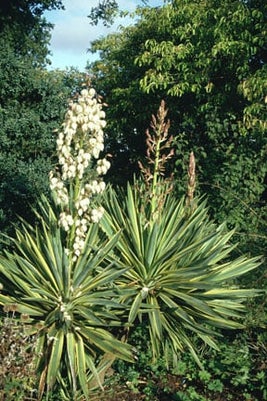
Quick facts
Common name - Yucca, Spanish bayonet, spineless yucca, Adam’s needle and thread, Spanish dagger
Botanical name - Yucca aloifolia, Y. elephantipes, Y. filamentosa, Y gloriosa
Group - Shrub or tree
Flowering time - Summer (sparsely)
Planting time - Spring
Height and spread - 55cm-10m (22in-33ft) by 1.5-8m (5-26ft)
Aspect - Outdoors full sun to light shade. Indoors bright, filtered light
Hardiness - Frost hardy to frost tender
Difficulty - Moderate
Cultivation notes
Yucca can be evergreen , shrubs or trees, with dense or loose of stiff, sword-shaped leaves and tall panicles of bell-shaped flowers. Larger forms gradually loose the lower leaves to expose a trunk. In frost-prone areas tender yucca species can be grown in a cool greenhouse or conservatory.
Outdoor planting
Hardier yucca like Yucca gloriosa and Y. filamentosa require full sun and any well drained soil.
Container cultivation
Add 20-30 percent by volume of extra grit to John Innes No 2 for good drainage. Place in full light, water freely during the from April to September and apply a balanced liquid feed fortnightly. During winter don’t feed and water sparingly allowing the surface 5cm of to dry out between watering, then water thoroughly, making sure that surplus water drains through the pot.
Indoor cultivation
Yucca requires a sunny position all year, well drained compost and careful watering. A south-facing window would be ideal in winter with an east or west-facing window in summer. Provide light shade from direct summer sun and ventilate freely to encourage air flow to reduce excessive high temperatures. Tender species like Y. elephantipes may be placed outside from the end of May to August in a sheltered spot provided the plant is stable in wind.
Winter protection
Over-winter all tender yucca indoors. During winter when not in active growth, Y. elephantipes can tolerate a minimum night temperature of 7°C (45°F) with a day temperature a few degrees higher so can be grown in a cool conservatory.
Flowering
Panicles of bell-shaped cream coloured flowers form in late summer to autumn but may need hand pollination to set seed.
Pruning and training
Pruning is not normally needed, but damaged leaves and spent flower spikes can be removed as necessary in the spring.
Turn indoor yuccas regularly to prevent them becoming lopsided as it grows towards the light. If the plant becomes too tall cut back and reduce the height by half. There is a slight risk but healthy plants should respond well. Reduce the plant in spring when growth resumes. The severed upper part can be used for propagation.
Propagation
In spring place stem 20-25cm long, measured from the tip, in coarse sandy rooting . Place in semi-shade in a with bottom heat of at least 18°C (65°F).
Offsets occasionally appear at the base of the plant. Remove offsets in March or April. Carefully expose the and cut it off at the base where it joins the parent rhizome. Allow the offset to dry for a couple of days and then place in a propagator as with cuttings or cover with polythene and place in a warm, light area but not direct sunlight.
Sow seed in spring at 13-18°C (55-64°F) for hardy yuccas and 19-24°C (66-75°F) for tender ones. To speed soak the seed for 24 hours before sowing.
Cultivar Selection
There is a good choice of both hardy and tender yucca listed in the RHS Find a Plant.
Yucca aloifolia: Tender. Simple or sparsely branched stem with terminal rosette of sharp-pointed leaves, bell-shaped white or purple-tinged flowers held above the foliage. Ideal for cool conservatory or as a house plant with min temp 7°C (45°F). Height 8m (25ft). Spread 4-5m (12-15ft).
Y. elephantipes: Tender. Large, upright shrub or small tree with several trunks growing from near ground level. Ideal for cool conservatory or as a house plant min temp10°C (50°F). Height 10m (30ft). Spread 5-8m (15-25ft).
Y. filamentosa: Hardy. Small stemless shrub, clump-forming, deep green leaves edged with curly filaments. Cream or green tinged flowers in panicles to 2m (6ft) in height in late summer. Recommended for hot dry borders and courtyards. Height 75cm (30in). Spread 1.5m (5ft).
Y. flaccida ‘Ivory’ AGM: Hardy. Clump-forming, stemless shrub with dark green leaves. White flowers freely borne in panicles 1.5m (5ft) long in mid- to late summer. Suitable for city and courtyard gardens and containers. Height 55cm (22in). Spread 1.5m (5ft).
Y. flaccida ‘Golden Sword’ AGM: Hardy. Clump-forming, stem-less shrub with lance-shaped leaves, drooping at the tip and with a central cream-yellow band. Cream-white flowers borne in panicles 1.5m (5ft) to late summer. Suitable for city and courtyard gardens and containers. Height 55cm (22in). Spread 1.5m (5ft).
Y. gloriosa(Spanish dagger): Hardy. Medium-sized shrub usually a single stem, spine-tipped, stiff, blue-green leaves. Late summer to autumn panicles 2.5m (8ft) in height, of cream, sometimes purple-tinged flowers appear. Ideal for hot dry borders and courtyards. Height and spread 2m (6ft).
Y. gloriosa ‘Variegata’ AGM: Hardy. Medium-sized single-stemmed shrub with stiff, spine-tipped, striped and edged creamy-yellow leaves. Late summer to autumn panicles 2.5m (8ft) in height, cream flowers appear. Ideal for hot dry borders and courtyards. Height and spread 2m (6ft).
Problems
Generally trouble free when grown outdoors though aphids can be a problem on flowers and snails may damage the leaves. Brown fungal spots can also appear on the leaves.
Indoors, a number of cultural problems can occur;
Crisp, brown lower leaves result from under-watering but lower leaves are natural shed as the plant grows.
Low light levels can result in sagging and drooping leaves but check for over or under-watering.
Some yellowing of lower leaves is normal. Sudden yellowing and limpness of lower leaves is due to overwatering. Reduce watering and allow the plant to virtually dry out. If the roots have begun to rot, remove the plant from the pot, and discard excess and rotting roots. Re-pot into a pot just large enough to contain the reduced root ball, using a small amount of fresh compost. Place in warm conditions and water sparingly.






